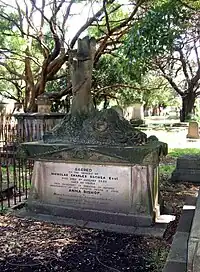Nicolas-Charles Bochsa
Robert Nicolas-Charles Bochsa (9 August 1789 – 6 January 1856) was a French harpist and composer. His relationship with Anna Bishop was popularly thought to have inspired that of Svengali and Trilby in George du Maurier's 1894 novel Trilby.[1]
Nicolas-Charles Bochsa | |
|---|---|
 portrait by Peter Copmann, 1837 | |
| Born | 9 August 1789 Montmédy |
| Died | 6 January 1856 Sydney |
| Occupation | Composer, harpist |
| Spouse(s) | Georgette Ducrest, Amy Wilson |
| Parent(s) |
|

Life
The son of a Bohemian-born musician, Charles Bochsa, Bochsa was born in Montmédy, Meuse, France.[lower-alpha 1] He was able to play the flute and piano by the age of seven. In 1807, he went to study at the Paris Conservatoire, winning the first prize in harmony the following year.[3] He was appointed harpist to the Imperial Orchestra in 1813, and began writing operas for the Opéra-Comique. However, in 1817 he became entangled in counterfeiting, fraud, and forgery, and fled to London to avoid prosecution. He was convicted in absentia, and sentenced to twelve years hard labour and a fine of 4,000 francs.[4]
Safe from French law in London, he helped found the Royal Academy of Music in 1821, and became its secretary. He taught there, amongst others, the British harp virtuoso Elias Parish Alvars. When his criminal conviction was revealed in 1826, he was forced to resign. He then became Musical Director of the Kings Theatre in London.
In 1839, he became involved in another scandal when he ran off with the opera singer Anna Bishop, wife of the composer Henry Bishop. They performed together in North America and throughout Europe (except France). In Naples Bochsa was appointed Director of the Regio Teatro San Carlo, (the Royal Opera House) and stayed there for two years.
Bochsa arrived with Bishop in Sydney, Australia, at the time of the gold rush in December 1855, but they gave only one concert together before Bochsa died. Bishop was heartbroken, and commissioned an elaborate tomb for him in Camperdown Cemetery.

Operas
Bibliography
- Michel Faul, Nicolas-Charles Bochsa, harpiste, compositeur, escroc (Éditions Delatour, 2003)
- Michel Faul, Les Tribulations mexicaines de Nicolas-Charles Bochsa, harpiste (Éditions Delatour, 2006)
Notes and references
Notes
- An obituary, undoubtedly informed by his lover Anna Bishop, described him as "a native of Prague, but at an early age became celebrated in Paris".[2] Birth at Montmédy is recorded (without verification) in the French Wikipedia article and in the 1969 monograph in Australian Dictionary of Biography.
References
- Lawrence, Vera Brodsky (1999). Strong on Music: The New York Music Scene in the Days of George Templeton Strong. Vol. 3 (1st ed.). Chicago: University of Chicago Press. p. 65. ISBN 978-0-226-47015-3. OCLC 60191288.
- "DEATH AND OBSEQUIES OF THE LATE M. BOCHSA". The Age. No. 390. Victoria, Australia. 18 January 1856. p. 4. Archived from the original on 29 June 2023. Retrieved 28 June 2023 – via National Library of Australia.
- Pierre, Constant (1900). "Chapter 11, Part 4: Dictionnaire des lauréats". Le Conservatoire national de musique et de déclamation (in French). Paris: Imprimerie nationale. p. 702.
- Lea-Scarlett, E. J. (1969). "Robert Nicholas Charles Bochsa (1789–1856)". Bochsa, Robert Nicholas Charles (1789–1856).
{{cite book}}:|work=ignored (help)
External links
- A site (in French) introducing the two books about Bochsa above
- Further documents
- Bochsa's tomb in Camperdown Cemetery
- Harp scores by Nicolas-Charles Bochsa from the International Harp Archives on archive.org
- Free scores by Nicolas-Charles Bochsa at the International Music Score Library Project (IMSLP)